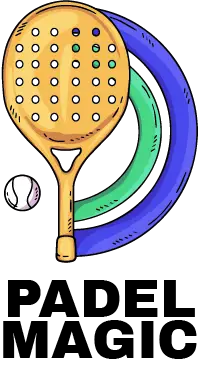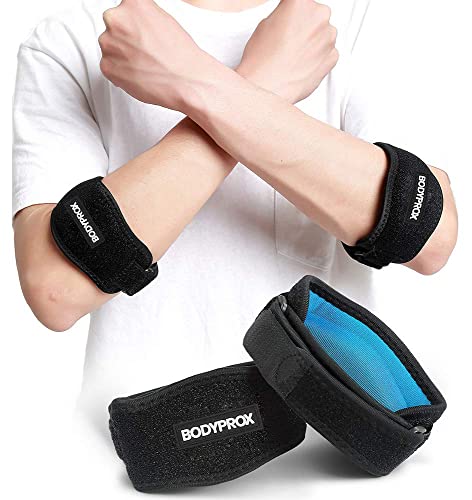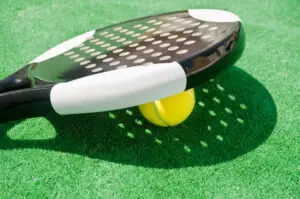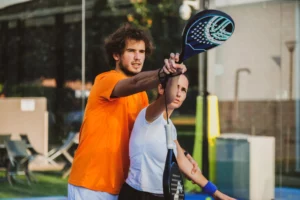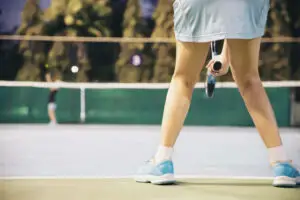Padel tennis has gained immense popularity in recent years, captivating players of all ages and skill levels. (Read more about Padel popularity)
This fast-paced sport, which combines elements of tennis and squash, has taken the world by storm, with courts popping up in clubs and recreational centers worldwide. However, with the surge in participation comes the need to address the potential injuries associated with padel tennis.
Importance of Addressing Padel Injuries
While padel tennis is generally considered a low-impact sport, injuries can still occur. The repetitive movements, quick changes in direction, and intense rallies can put a strain on various parts of the body.
It is crucial to address these injuries to ensure the long-term health and well-being of players. By understanding the common types of injuries and their causes and implementing prevention strategies, we can promote safe and enjoyable play in the world of padel tennis.
Common Padel Tennis Injuries
Padel tennis, like any sport, comes with the risk of injuries. Understanding the common types of injuries that can occur while playing can help players take preventive measures and seek appropriate treatment when necessary. Here are some of the most common padel tennis injuries:
Ankle Sprains
Ankle sprains are one of the most prevalent injuries in padel tennis. They often happen when players land awkwardly or make sudden lateral movements, causing the ligaments around the ankle to stretch or tear. Proper warm-up, wearing supportive footwear, and strengthening exercises can help reduce the risk of ankle sprains.
In the unfortunate event that you’ve sustained an injury despite your precautions, we’ve received numerous endorsements for a specific product that might help ease your recovery process. However, it’s crucial to seek professional medical advice prior to making a purchase.
United Ortho USA14115 Short Air Cam Walker
- It provides maximum stability and support following injury or post-operative procedures. It can be used for acute ankle sprains, soft tissue injuries, stable lower leg, foot, and ankle fractures, and post-operative use.
- It features a rocker sole and a shock-absorbing insole, which reduce the impact of heel strikes when walking and help promote a natural gait.
- The boot is universally designed to fit either the right or left foot.
How to Prevent an Ankle Sprain Playing Padel?
To prevent ankle sprains while playing Padel, it’s essential to prioritize a superhero warm-up routine that includes stretching and preparing your body for action.
Mastering balance through targeted exercises will strengthen your ankle muscles and provide stability during intense gameplay.
Focus on honing your technique and footwork to minimize the risk of ankle sprains while showcasing your padel skills. Equipping yourself with the right pair of padel-specific shoes that offer ankle support, cushioning, and grip is crucial.
Stay alert on the court, keeping an eye out for potential hazards and maintaining court awareness to avoid unexpected accidents.
Strengthening your ankles through exercises like squats and lunges will provide them with the resilience needed to prevent injuries. By following these tips, you’ll become a padel superstar, free from ankle sprain worries and ready to conquer the court with confidence!
Warm Up PROPERLY To Play Your Best Padel!
Knee Injuries
Knee injuries can occur due to the repetitive nature of the sport and the strain placed on the knee joints during movements such as running, stopping, and pivoting.
Common knee injuries in padel tennis include ligament sprains, meniscus tears, and patellar tendonitis. Strengthening the muscles around the knee and using proper techniques can help prevent knee injuries.
We have received numerous commendations from pedal players who have experienced knee injuries, expressing how our product significantly aided them in their rehabilitation process.
REVIX Ice Pack for Knee Pain Relief
The REVIX Knee, Ice Pack Wrap, is a remarkable product designed to provide effective relief and support for individuals with knee injuries.
Whether you're a sports enthusiast, an active individual, or someone recovering from a knee-related ailment, this product aims to assist you on your journey to recovery.
The adjustable straps allow for a personalized fit, providing stability and support to the injured area. You can easily adjust the compression level to meet your specific needs, ensuring a snug yet comfortable fit.
Tennis Elbow (Lateral Epicondylitis)
Tennis elbow, also known as lateral epicondylitis, is a condition characterized by inflammation and pain on the outer side of the elbow.
It can occur from repeated gripping and swinging motions, leading to strain on the tendons. Adequate rest, proper technique, and forearm strengthening exercises can help prevent and manage tennis elbow.
We have discovered a product that comes highly recommended by Padel players for recovering from tennis elbow injuries.
This product has received praise from players who have experienced the debilitating effects of tennis elbow and found significant relief through its use.
With its unique design and specialized features, it aims to provide effective support and aid in the rehabilitation process.
Bodyprox Elbow Brace 2 Pack for T
This unique brace has received rave reviews from athletes and elbow warriors alike, and it's no wonder why. With its sleek design and innovative features, it's like having a personal cheerleader for your elbow!
Crafted with precision and engineered for comfort, the Elbow Brace provides targeted support right where you need it most. Its adjustable straps ensure a customized fit so you can get back in the game confidently. No more worrying about your swing or your backhand; this brace has got you covered!
The Elbow Brace doesn't just look stylish; it's also a pro at reducing pain and inflammation. Its strategic compression technology helps improve blood circulation, promoting faster healing and recovery.
Shoulder Injuries
Padel tennis involves frequent overhead shots and repetitive arm movements, which can put a strain on the shoulder joint and surrounding tissues. Shoulder injuries such as rotator cuff strains, shoulder impingement, and Labral Tears can occur.
Proper warm-up, shoulder-strengthening exercises, and maintaining good shoulder mechanics can reduce the risk of shoulder injuries.
Muscle Strains and Tears
Padel tennis requires quick accelerations, decelerations, and explosive movements, which can sometimes lead to muscle strains or tears.
Common areas prone to muscle injuries include the calf, hamstring, quadriceps, and groin muscles. Proper warm-up, conditioning exercises, and gradual progression of intensity can help minimize muscle injuries.
It is important for padel tennis players to be aware of these common injuries and take appropriate precautions to minimize the risk.
This includes wearing proper Padel shoes, warming up adequately, using correct techniques, and incorporating strength and flexibility training into their routine.
Additionally, seeking prompt medical attention and following a proper rehabilitation plan is crucial in the event of an injury.

Causes and Risk Factors of Padel Injuries
Padel injuries can occur due to various causes and risk factors. Understanding these factors is crucial for players to take proactive measures in order to minimize the occurrence of injuries and maintain their well-being on the padel court. Let’s take a closer look at the common causes and risk factors associated with padel injuries:
Improper Warm-up and Stretching
Failing to warm up properly before engaging in padel activities can significantly increase the risk of injuries. Without a proper warm-up routine, the muscles, tendons, and joints are not adequately prepared for the physical demands of the game.
This can lead to muscle imbalances, reduced flexibility, and decreased range of motion, making players more susceptible to strains, sprains, and other injuries.
Incorporating dynamic warm-up exercises and targeted stretching into the pre-game routine is essential to increase blood flow, warm up the muscles, and improve joint mobility.
Precisely because of the importance of a proper warm-up and its benefits to your health and performance, we’ve done the research for you and found the perfect product for your stretching exercises.
The Fit Simplify Resistance Loop Exercise Bands will not only help prepare your muscles for the game but also contribute to your overall health and well-being.
The Fit Simplify Resistance Loop Exercise Bands. Resistance bands are a versatile piece of fitness equipment that is perfect for a padel warm-up routine. They are lightweight, portable, and can be used to perform a variety of exercises that target different muscle groups.
Fit Simplify Resistance Loop Exercise Bands with Instruction Guide and Carry Bag, Set of 5
The Fit Simplify Resistance Loop Exercise Bands. Resistance bands are a versatile piece of fitness equipment that is perfect for a padel warm-up routine. They are lightweight, portable, and can be used to perform a variety of exercises that target different muscle groups.
Overuse and Repetitive Motions
Padel, like any sport, involves repetitive motions that can put a strain on specific muscles, tendons, and joints.
Continuous and repetitive swings, movements, and footwork patterns without adequate rest and recovery periods can lead to overuse injuries.
These injuries develop gradually over time and are often caused by Microtrauma to the Tissues. Common overuse injuries in padel include tendinitis, stress fractures, and muscle imbalances. It is important to strike a balance between training, matches, and rest days to prevent overuse injuries and allow the body to recover.
Lack of Proper Technique and Form
Executing padel drills and movements with incorrect technique and form can contribute to injuries.
Poor technique can place excessive stress on certain body parts, leading to strains, sprains, and overuse injuries.
It is crucial to receive proper training and instruction from experienced players or coaches to develop sound techniques and ensure efficient movement patterns. This not only enhances performance but also reduces the risk of injuries.
ALSO READ: Padel Tips
Inadequate Footwear and Equipment
Wearing improper Padel shoes and using inadequate equipment can increase the risk of injuries in Padel.
Shoes without appropriate support, cushioning, and grip can result in slips, falls, and ankle sprains. Ill-fitted or worn-out equipment, such as rackets or grips, can compromise performance and lead to strain on the wrists and arms.
Investing in high-quality padel shoes that provide excellent support, cushioning, and traction, as well as using properly maintained equipment, is essential for injury prevention.
Playing on Hard Surfaces
The playing surface can also play a role in padel injuries. Hard surfaces, such as concrete or asphalt courts, lack shock absorption compared to surfaces like synthetic grass or clay courts.
Playing on hard surfaces can increase the impact on joints, potentially leading to discomfort, joint pain, and stress-related injuries.
Whenever possible, selecting courts with suitable surfaces that offer better shock absorption can help reduce the risk of impact-related injuries.
By being aware of these causes and risk factors, padel players can take appropriate precautions to minimize the likelihood of injuries. Prioritizing a comprehensive warm-up routine, focusing on correct technique and form, using suitable footwear and equipment, and selecting appropriate playing surfaces are vital steps in preventing injuries and ensuring a safe and enjoyable padel experience.
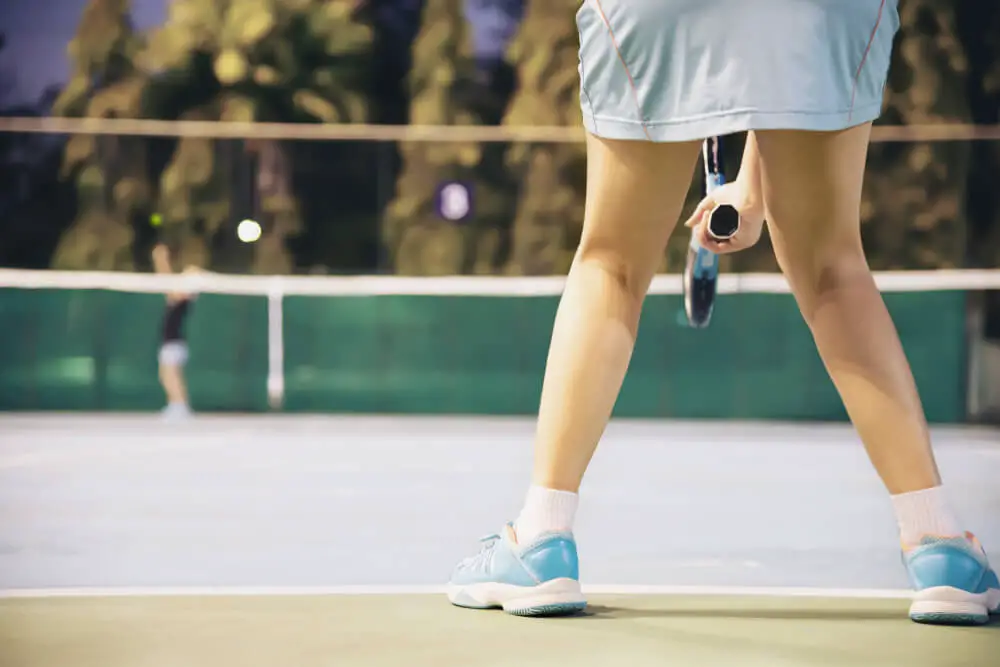
Treatment and Rehabilitation: Bouncing Back Like a Padel Rockstar!
Uh-oh, it happens to the best of us – an injury on the padel court. But fear not, my fellow Padel rockstars!
With the right treatment and rehabilitation strategies, you’ll be back in action in no time. So, let’s dive into the world of recovery and get you back to smashing those powerful shots!
R.I.C.E. Protocol (Rest, Ice, Compression, Elevation):
Think of R.I.C.E. as your personal superhero team swooping in to save the day! When an injury strikes, it’s time to give yourself some well-deserved rest.
Take a break, put those feet up, and let your body heal. Ice becomes your icy-cool sidekick, reducing inflammation and soothing those aching muscles. Compression steps in like a trusty sidekick, wrapping around the affected area to provide support and minimize swelling.
And finally, elevation plays its part by raising the injured area above heart level, helping to reduce swelling and promote efficient healing. Together, they form the ultimate healing squad!
Physical Therapy and Rehabilitation Exercises:
It’s time to embark on your very own padel rehabilitation adventure! Physical therapy is like having a personal trainer who specializes in getting you back in shape for the game.
Through targeted exercises, stretches, and hands-on techniques, your physical therapist will guide you on a path to recovery. They’ll help you rebuild strength, improve flexibility, and restore your padel-specific movements. It’s like having your very own padel guru cheering you on every step of the way!
Medications and Pain Management:
When the going gets tough, it’s okay to call in reinforcements! Sometimes, injuries come with a bit of discomfort or pain.
That’s where medications and pain management strategies step in. Consult with your healthcare provider to discuss suitable options that can help manage pain and reduce inflammation.
They’ll provide you with the best advice and ensure you have a game plan to keep you comfortable during your recovery journey.
Rest and Modified Activity:
Patience, my padel friend! The road to recovery may require some modifications to your usual routine.
It’s important to listen to your body and give it the time it needs to heal. Take things at a pace that’s right for you, gradually reintroducing activity as advised by your healthcare provider.
They’ll guide you on when it’s safe to hit the court again. Remember, rest is an essential part of the healing process, and modified activity allows you to stay engaged while giving your body the chance to regain its full strength.
With the power of the R.I.C.E. protocol, the guidance of your trusted physical therapist, the support of pain management strategies, and the patience to rest and modify your activities, you’ll be back on the padel court before you know it.
Just imagine that triumphant return, stepping onto the court with confidence and a renewed passion for the game. So, put on your imaginary superhero cape, embrace the journey, and get ready to make your comeback like a true Padel rockstar!
Returning Safely to Play: Bouncing Back Like a Padeltastic Pro!
Congratulations, padel champion! You’ve conquered your injury, defeated those pesky setbacks, and now it’s time to make your triumphant return to the padel court.
But hold your racquets, my padel pal, because we want to ensure you come back stronger than ever and ready to rock. Let’s dive into the world of safely returning to play and get you back to your padel adventures in the most epic way possible!
Gradual Return to Play Protocol:
Picture this – you, back on the padel court, with a renewed sense of determination and excitement. But remember, even superheroes need a plan! It’s crucial to take things one step at a time and gradually reintroduce yourself to the game.
Start with light training sessions or practice matches to assess your readiness and build up your endurance.
It’s like unlocking levels in a video game – each step brings you closer to your full padel potential. As you feel more confident and comfortable, slowly increase the intensity and duration of your play.
Before you know it, you’ll be back to your Padel superhero status, dazzling the court with your skills!
Consultation with Healthcare Professionals:
Every superhero needs a team of trusted advisors, and your healthcare professionals are your padel allies.
They have the expertise to evaluate your progress, assess your readiness, and provide valuable advice on when and how to return to the court safely.
Whether it’s a visit to your doctor, physical therapist, or sports medicine specialist, their guidance will ensure you’re on the right track to padel greatness.
They’ll cheer you on, provide valuable tips, and make sure your comeback is as smooth as a well-executed lob shot!
Frequently Asked Questions
Common injuries in padel include strains or sprains in the ankle, wrist, and knee, as well as shoulder and elbow overuse injuries such as tendonitis. Additionally, muscle strains and minor contusions can occur due to the fast-paced nature of the game.
Padel tennis is generally considered a low-impact sport, which means it puts less stress on the knees compared to high-impact activities like running or jumping. However, improper technique, overuse, or sudden movements can still lead to knee injuries. It is important to use proper form and gradually increase activity levels to minimize the risk of knee issues.
To prevent padel injuries, it’s crucial to warm up adequately before playing and to maintain overall physical fitness
Padel involves dynamic movements, quick reflexes, and repetitive strokes, which can help improve muscular endurance and tone certain muscle groups. While padel can contribute to overall fitness, it may not be the most effective form of exercise solely for muscle building. Combining padel with targeted strength training exercises can help enhance muscle development.
Padel, like any sport, carries a risk of injuries, but the overall injury rate in Padel tennis is considered moderate.
Padel can involve sudden movements, repetitive motions, and high-intensity play, which may pose some risks. However, when played with proper technique, appropriate conditioning, and adherence to safety guidelines, the risk of injury can be effectively managed. It’s important to take proper precautions and listen to your body to stay safe and enjoy the sport.
Shoulder pain after playing padel could be due to overuse, poor technique, or muscle imbalances. Repetitive overhead shots or improper stroke mechanics can strain the shoulder joint and its surrounding muscles. It’s advisable to consult a healthcare professional for an accurate diagnosis and to receive appropriate treatment and rehabilitation exercises.
Padel involves a combination of cardiovascular endurance and muscular engagement. It primarily targets muscles in the legs, including the quadriceps, hamstrings, and calves, as well as the core muscles, such as abdominals and obliques. Additionally, the upper body muscles, including shoulders, arms, and back, are engaged during strokes and volleys.
Post-padel pain can be attributed to several factors, including muscle soreness from intense activity, muscle imbalances, overuse, or improper form. It’s important to gradually increase activity levels, warm up adequately, and cool down after playing to minimize discomfort. If the pain persists or worsens, it is advisable to seek medical advice.
Strains in padel commonly occur in the leg muscles, such as the quadriceps or calf muscles, due to sudden movements, changes in direction, or explosive shots. Additionally, strains can occur in the shoulder muscles due to repetitive overhead movements or in the forearm muscles due to excessive gripping and swinging motions.
